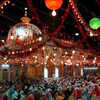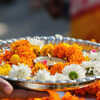
In the heart of Nagpur, every Shravan season, something extraordinary happens. Streets fill with colors, music, and giant effigies as locals celebrate the Marbat Festival, a 150-year-old tradition unlike any other in India. What makes it special is not just the fiery spectacle of burning Marbats but the deep symbolism of defeating evil, purifying society, and strengthening unity.
What is the Marbat Festival?
 urs-festival: A Sufi Celebration of Harmony The Marbat Festival, observed primarily in Nagpur, is celebrated on the second day of the Shravan month according to the Hindu calendar. The festival features massive effigies called Marbats (made of bamboo, hay, paper, and cloth), which symbolize evil forces, negativity, and social evils. These towering figures are paraded across the city before being set on fire, signifying the destruction of evil and the triumph of good.
urs-festival: A Sufi Celebration of Harmony The Marbat Festival, observed primarily in Nagpur, is celebrated on the second day of the Shravan month according to the Hindu calendar. The festival features massive effigies called Marbats (made of bamboo, hay, paper, and cloth), which symbolize evil forces, negativity, and social evils. These towering figures are paraded across the city before being set on fire, signifying the destruction of evil and the triumph of good.
The Origins of the Festival
 Full moon festival, starts Purnima a day earlier Historical accounts trace the festival back to the mid-19th century during a time when epidemics like cholera and plague plagued Nagpur. People believed that such disasters were caused by demonic forces or negative energies. To counter this, the community began creating effigies of evil spirits and burning them to drive away illness and darkness. Over time, this practice evolved into today’s vibrant Marbat Festival.
Full moon festival, starts Purnima a day earlier Historical accounts trace the festival back to the mid-19th century during a time when epidemics like cholera and plague plagued Nagpur. People believed that such disasters were caused by demonic forces or negative energies. To counter this, the community began creating effigies of evil spirits and burning them to drive away illness and darkness. Over time, this practice evolved into today’s vibrant Marbat Festival.
The Grand Procession
 The festival day is nothing short of electrifying. Two giant effigies, the Kali (black) Marbat and Pivli (yellow) Marbat, are carried through the city in a huge procession. The streets echo with dhol beats, chants, traditional songs, and dancing. Local artisans spend weeks creating these effigies, painting them in bold colors to represent demonic energies or even social evils of modern times—ranging from corruption to inflation.
The festival day is nothing short of electrifying. Two giant effigies, the Kali (black) Marbat and Pivli (yellow) Marbat, are carried through the city in a huge procession. The streets echo with dhol beats, chants, traditional songs, and dancing. Local artisans spend weeks creating these effigies, painting them in bold colors to represent demonic energies or even social evils of modern times—ranging from corruption to inflation.
Social Commentary Through Marbats

Devotees participate in the annual chariot procession of Hindu deity Lord Jagannath, in Ahmedabad, India, Friday, June 27, 2025. (AP Photo/Ajit Solanki)
What makes the Marbat Festival unique is how it adapts to the times. Effigies don’t just represent mythical demons—they often reflect current political, social, and economic issues. For example, some Marbats have been crafted to symbolize global warming, rising prices, or even corrupt practices. This ability to combine tradition with modern relevance makes the festival stand out as a living cultural commentary.A Festival of Unity and SpiritThe Marbat Festival is not bound by religion or caste, it belongs to everyone in Nagpur. The burning of Marbats is more than ritual; it’s an act of collective hope, faith, and resilience. It brings together people across communities to remind them that evil, whether personal, social, or spiritual, can be defeated when society stands united.
A Fire That Purifies SocietyThe Marbat Festival is more than a spectacular display, it is a timeless tradition that blends history, faith, and social relevance. As the effigies rise in flames, they take with them the fears, evils, and negativity of society, leaving behind only hope, unity, and renewal. That’s why, for over 150 years, this fiery celebration has remained the pride of Nagpur and a symbol of the city’s spirit.
Unlock insightful tips and inspiration on personal growth, productivity, and well-being. Stay motivated and updated with the latest at My Life XP
-
Drinking less than 1.5 litres water a day? Study reveals link between hydration

-
AIIMS gastroenterologist says ‘slightly green bananas benefit gut, not overripe’; shares 9 food facts you didn’t know

-
Orthopedic doctor explains how desk jobs affects joints, warns against stiffness and weakness

-
DMart Stock Surges With Bullish Signals; SEBI Analyst Says Next Leg Could Take It To ₹6,000

-
Who is Squadron Leader Priya Sharma? Mig-21’s last flight with Air Chief Marshal played a special role. Who is Squadron Leader Priya Sharma Role in Air Force Mig 21 Retirement Flight
